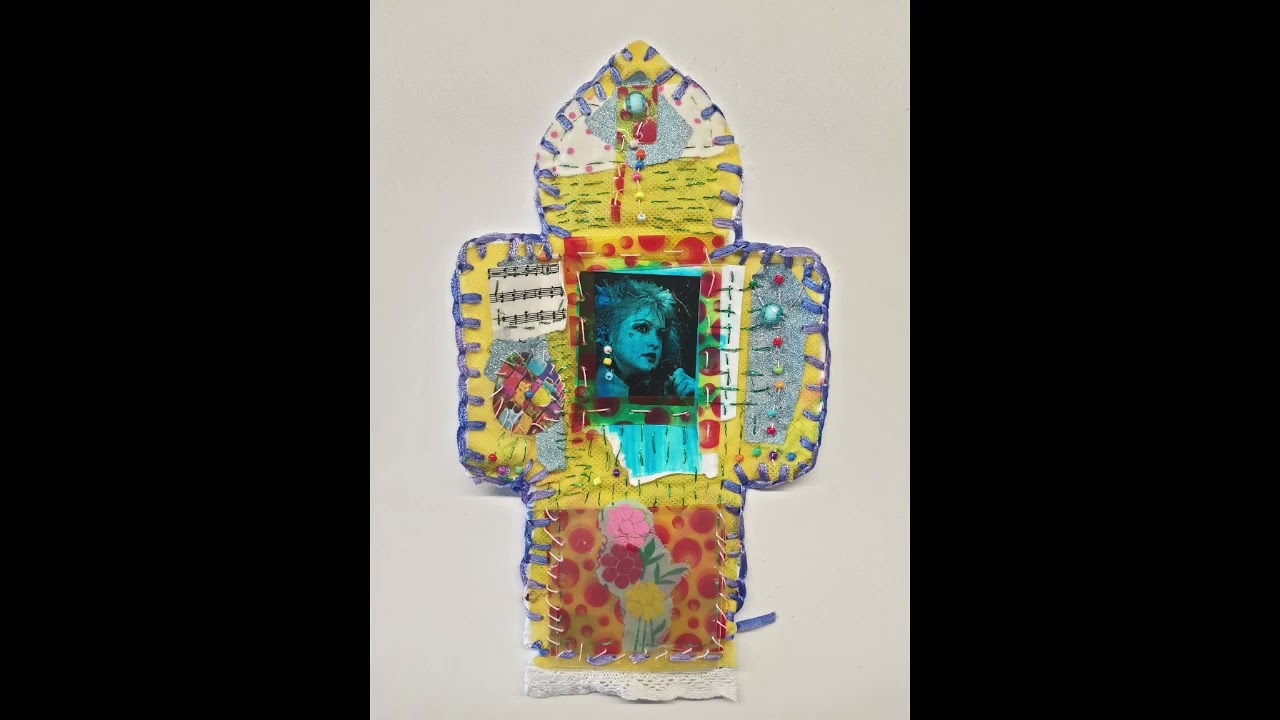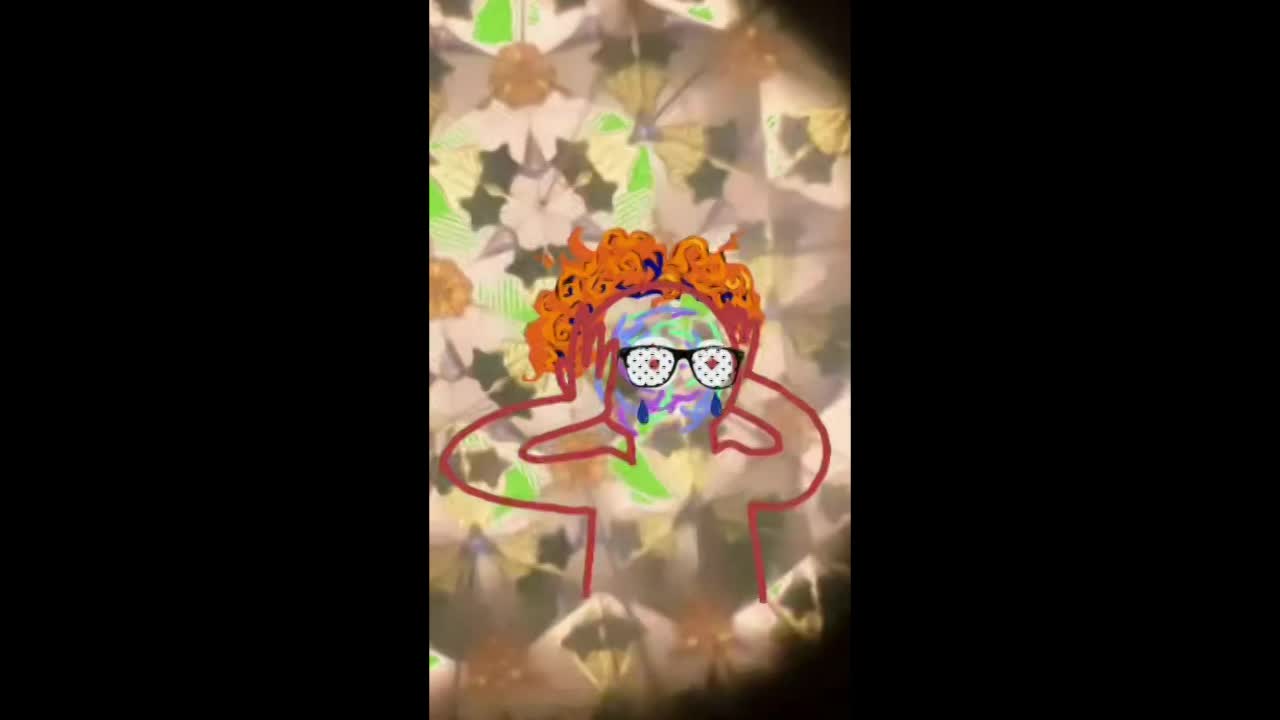My shrines & my brain
This is a post about how my bipolar brain influences my propensity for making stuff. It needs a few disclaimers –
- Everyone’s bipolar is different! I speak for myself only.
- I’m talking about just one aspect of my bipolar and just one aspect of my making. There’s lots of other stuff going on.
- It's not my intention to reduce bipolar to a 'brain-only' condition or experience, because it isn't.
- I’m working from my own understanding of some complex ideas. I think I maybe mostly kinda sorta have the gist but do not speak with any proper knowledge or authority.
- My desire to make is influenced by all kinds of things – environment, community, genetics, access to felt pens etc. But this post is just about the brain bit.
If you can be arsed to look at my social media history, you will notice bursts of activity where I make and post lots of a particular type of thing and then stop. Some examples are,
There are many more, some on this blog (as posts or in the gallery) and lots that aren’t because they’re secret, lost, forgotten, given as gifts, thrown out, or in boxes under my bed. Each ‘set’ is made in the same way – consistently, specific to an idea and/or medium, and in a relatively short period of time (between two weeks and a year). As I said in the introduction, the things I make and the way I make them are influenced by a multitude of factors but this post focusses only one – my bipolar brain.
My latest making flurry’s been pocket shrines. I made twenty of these over the 2023 Christmas and new year period. Here they are:
Twenty pocket shrines
The video tells you all you need to know about the pocket shrines as objects and I don’t plan to write much more about this. Rather I’m going to use the process of creating the shrines as a context for exploring the making-related role of my bipolar brain.
The bipolar brain
The first thing to say is that bipolar disorder is not just about the episodes; the ups and downs, the mania and depression. These moods are related to a particular type of brain which is always there, affecting your life in a myriad of ways. The neurological situation is complicated and contested, there are lots of big words, and experts do not know exactly how it all works. They are pretty sure though, that the brains of those with bipolar and those without look and perform differently.
Here are some things scientists reckon –
- Bipolar brains have less gray matter. This is the outermost part of the brain responsible for many important daily-life things like processing sensory information, impulse control, movement, making plans, and storing memories. Gray matter seems to be particularly lacking in the prefrontal and temporal cortexes.
- The hippocampus, a part of the brain that supports memory, emotional regulation and learning is smaller.
- The neurotransmitters dopamine, serotonin and/or norepinephrine are out-of-balance. Sometimes there’s too much and/or it’s moving too quickly, sometimes there’s not enough and/or it’s moving too slow. These chemicals are responsible for shitloads of things including mood, appetite, sleep, alertness, sexual desire, social behaviour, coordination, and feelings of pleasure and reward.
- Mitochondria are impaired. Mitochondria are the powerful cells and mechanisms that regulate energy and metabolism. As part of this job they determine which brain cells survive and which ones die.
- The balance of sodium and calcium is out-of-whack. These elements affect the channels responsible for the firing of neurons and their flow in and out of cells.
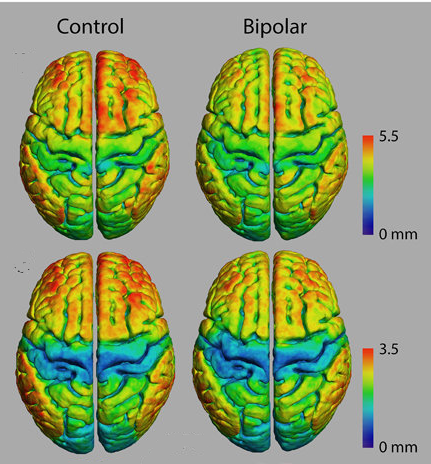
Confusingly, in this picture the gray matter's red. But whatever the colour, there's less of it.
The unique bipolar brain manifests through various cognitive processes and behaviours. Some of the classics are goal pursuit, increased processing speed, dissociation, heightened senses, psychomotor agitation, hyper-fixation, and connection overload. These are the ones I’m going to write about.
Creativity and mania
Creativity and bipolar are often seen as connected. Some of this comes from auto/biographical accounts of individuals who achieve things and in doing so display signs of the disorder. There’s also quantitative research which attempts to measure the relationship between the two. Both kinds of information invariably cover how the workings of a bipolar brain can facilitate traits associated with creativity, and how mania is generally the state within which these creative traits go POW.
Mania manifests in all kinds of ways. It can be enormous and terrifying, manageable and interesting, and everything in between (though contrary to the telly, it’s hardly ever a doe-eyed very hot girl who wants to fuck dorks in weird places, or a psychotic face-painted baddie with a mother complex, or an insomniac mystery-solving genius with a penchant for post-it notes).
My creative mania is comparatively little and specific, what’s called hypomania. Episodes are time-bound, familiar and regular (at least once a year) with no serious negative life consequences. They occur even though I’m on medication and I’m self-aware throughout (probably because of the meds). They are both awesome and horrible.
The episodes also have a predictable trajectory. My plan for the rest of the post is to break this trajectory down and link each part with the relevant bipolar feature(s), using the pocket shrines as context (although in real life the parts aren’t separate but simultaneous and tangled).
Pursuing the goal
The first part of a making frenzy involves me getting interested in something. Really interested. Really really interested. The interestedness always includes a desire to learn and in order to learn I need to make. For example I made these drawings to learn about comet ladies and I made these drawings to learn how to use Adobe Fresco. (For me the term ‘make’ includes anything that’s involved, including research, i.e. with the pocket shrines, before I could construct one for a particular deity, I needed to find out about that particular deity. Also ‘making’ includes writing, as in I'm 'making' this blog post).
The desire to learn and make is not a specific bipolar thing. For a biologically vulnerable brain however, a desire can quickly morph into a goal. And a goal can easily act as the trigger for a manic episode. The goal-regulating bits of the bipolar brain are quite dodgy, meaning our reward sensitivity is off the charts, meaning that reaching a goal feels very very good. So good we’ll do weird, speedy, obsessive, manic things to get there. This is an accurate description of me.
I am not always sure where a specific interest originates but the pocket shrines definitely came from a picture sent to me by a friend. She thought I’d like them and oh yes, I really truly did. I was instantly fascinated and enamoured and wanted to know more and wanted to make some. Wanting to know, wanting to make = goals and it’s hypomania here I come!
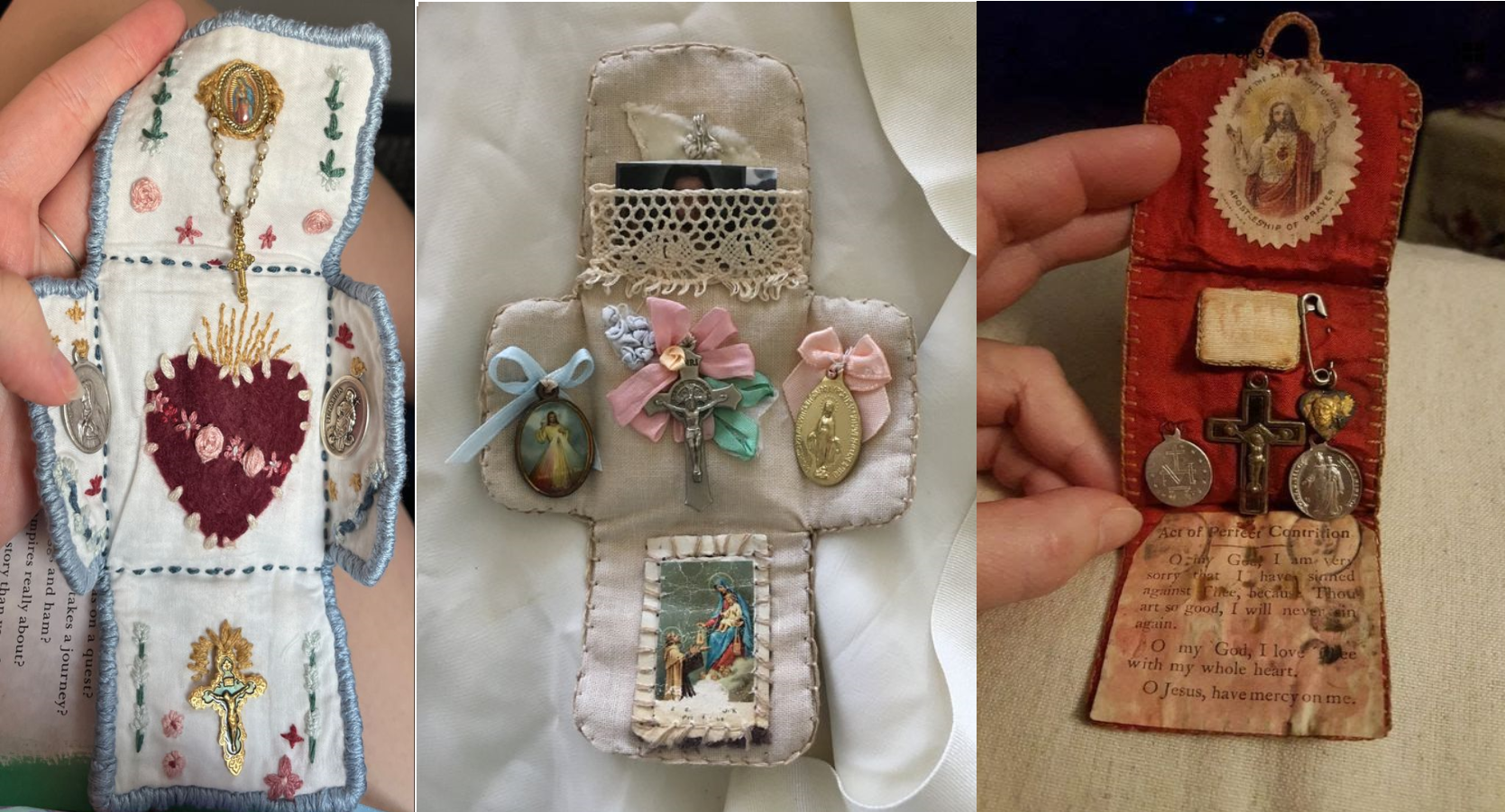
Beautiful traditional Catholic pocket shrines. I
I am the Master
The first pocket shrine I made was quite crap but in producing it I figured out the essentials. My second shrine turned out (I thought) great, setting the standard for all the rest. By shrine two I had the process sussed. I ‘knew’ what I was doing.
Changes in mental processing speed are a pretty standard feature of bipolar disorder. It generally gets faster when individuals are manic and slower when they’re depressed. For me in my hypomania, there’s a sweet spot where my processing is perfect. I become a glorious learning entity and knowledge and skill are easy as fuck to acquire. (My mental processing speed does keeps increasing after this point, which - as you’ll read – is problematic).
Once I know what I’m doing, doing it becomes stupidly easy. With the pocket shrines there was no planning or deliberation. I didn’t try a variety of layouts or practice stitching or faff about choosing images. Nor did I worry about how they’d turn out. I just ‘knew’ and I made each shrine straight up, first time (and I got the reward-rush. Yuss).
This mastery thing feels very strange. At first it’s fantastic and I am all in, synapses firing. Then suddenly my mind dissociates from my body and the learning seems to bypass my brain. It's like my hands understand how to make shrines all on their own, no cognition required. And I experience it at a distance, watching my hands but having little to do with their movements. I am similarly removed from my emotions. I can’t say I felt nothing. There was happiness but it was foggy and far away.
I can see clearly now
When I was making the shrines I could see everything – the weave in a piece of fabric and the individual holes in the individual beads in the bead jar. Threading a needle was ridiculously easy, the eye was large and the thread was solid, it barely touched the edges going through.
Hyperesthesia or heightened senses is textbook bipolar, and can manifest in any or all senses. An amplified smelling ability is apparently common but my experience is all vision. It was pretty useful for making shrines, for threading needles but also putting glue in the right places and evenly spacing out stitches (again though, it’s my hands that ‘know’. There’s some kind of direct, brain-bypassing eye to hand channel). But it also gets tiring and overwhelming and can give me a wee headache. Sometimes I need to shut my eyes for a bit.

My first quite crap shrine
Speedy speedy
The first good pocket shrine (not the one just above) took a comparatively long time to finish, maybe a couple of days. The next one took about half that time. From there it just got faster and faster, peaking at about three shrines a day, all made simultaneously. This is the classic face of mania, the speedy bit, the bit on the telly where someone’s furiously scribbling intimidating maths equations all over a black board or pirouetting like a whirlwind over and over and over until their feet bleed. In real life though, manic activity doesn’t usually end in anything of great value to others (often it doesn’t produce anything at all).1 There's no useful scientific formula for magnetic flux or triumphant version of Swan Lake.
Rather it’s just confusing, an activity that makes little or no sense to anyone except the individual involved, like my pocket shrines. I am lucky to have friends who are into them but to the wider world the whole thing is objectively bonkers, “what the fuck is a pocket shrine and why the fuck would anyone ever need twenty of them ever?!” I hear you ask. I have no answer.
Bipolar speediness is thought to be the result of a few different things. One is the mind-body detachment, i.e. my hands didn’t need to wait for my mind and could just go for it. Another is the increased processing speed of the brain which I talked about earlier. There’s also a neurotransmitter transporter disfunction that gives us way too many pleasure, motivation and energy chemicals2 (this relates closely to the goal/reward pursuit thing). And there’s psychomotor agitation, an irresistible need to move. With the shrines it was my hands, both of them simultaneously, magically making.3
Experiencing time
Related to the speeding situation is the way those of us with bipolar disorder experience time. It’s to do with an uneven balance between the somatomotor and sensory networks and it means that during an episode an individual’s sense of inner time (self) and outer time (the world) desynchronize and become opposites. So when we’re manic, inner time is too fast and outer time is too slow. When depressed, inner time’s too slow and outer time’s too fast.
The world did seem unreasonably slow while I was making the pocket shrines. I had friends still working on their first while I was on my tenth and honestly, I did wonder what was taking them so long.
Hyper-fixation and connection overload
As the word suggests, hyper-fixation refers to the strong and intense fixation on a particular object, activity or topic, to the point where it becomes difficult to focus on anything else. Essentially, it’s a scientific word for obsession (literal obsession not OMG I’m OBSESSED).
When I was making the pocket shrines I was obsessed. Enabled by the summer holidays, I could pretty much shrine all day, waking up early and staying up late and wearing my pyjamas. I'm so lucky - my making mania is small and I’m self-aware so I didn’t neglect my children, although neither live with me so I had heaps of noncontact time and shamefully I was grateful. I also managed to spend time with friends because I knew it would be good me but shamefully I had to force myself. (Of course, both things were lovely once I (physically and mentally) got there).
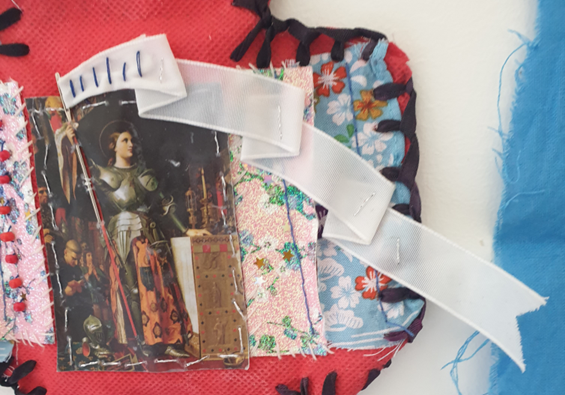
Joan of Arc and her footpath ribbon flag
Related to hyper-fixation is a thing called apophenia. Apophenia refers to a state of abnormal, excessive mental connection-making. For me in a making frenzy it manifests as an environment chock full of associations with the subject of my obsession. So every shop was full of perfect shrine-making stuff and every walk full of amazing shrine-making inspiration. I saw a stick insect and of course! It’s obvious! The stick insect’s telling me it needs a shrine. I heard an ambulance siren and of course! It’s obvious! I need to make a wailing banshee shrine. I found a piece of pristine white ribbon on the footpath and of course! It’s obvious! It’s Joan of Arc’s flag and it needs a shrine. All true.4
At the start apophenia is quite amazing, there’s the sense of pretty pastel-coloured web splaying out from my mind and linking all the bits of the world together. I get a bit puffed up, consider myself quite special and pity all the mortals who do not have it.
Pretty quickly though it becomes too much. Remember how I talked about my brain’s processing speed increasing and that this made learning easy? Well, a big part of learning is making connections and as my brain gets faster the connections get more and more frequent and loud and ridiculous and it becomes overwhelming. The web turns eye-wateringly fluorescent and gets tangled and start zapping about between everything (my heightened vision doesn’t help). It is over-stimulating but also suffocating and my mind gets way too full. Ideas overlap, sneer, flash and clamour for attention and I cannot keep up. It hurts physically and emotionally, and inevitably makes me cry (sometimes in the street. So embarrassing!)
Feeling overwhelmed
Moving the goal post
However! Like I said, in a making mania I am self-aware (again, I'm very lucky) and because of this I’m able to enact an apophenia-minimizing strategy, one that harnesses another trusty episode characteristic, goal pursuit.
It works like this – I cry until I get to the end of crying. Then I have some kind of relaxing drug (I have a few options) and a cup of tea. Next I set an overarching objective, a definitive, no-nonsense end-of-making point like twenty pocket shrines. In doing this I change the goal. It moves from completing an individual shrine (traumatic, potentially infinite) to completing a group of shrines (manageable, finite).
It works. I am still irrationally desperate to achieve the goal, but with an end in sight I can cope with the dissociation, hyper-fixation, apophenia and whatever else. And when I get to the end, the reward rush is soooo good. The goal is bigger so the bipolar brain bounty is too.
At twenty pocket shrines I stopped making. I wooshed free of hypomania and looked at the shrines over and over and loved them deeply and felt proud. And it all seemed worth it, like it always does.
P.S. I have since made a couple more pocket shrines but in a much slower, more sensible way. The frenzy is over and it’s now just a nice craft activity.
_______________________
1 Virginia Woolf's novels, Van Gogh's paintings etc. are the exception, absolutely not the rule.
2 Dopamine, serotonin, norepinephrine - you know it!
3 My shrine-related psychomotor agitation was useful but often it exists without a purpose, manifesting as wriggling, pacing, fiddling with things etc.)
4 My apophenia is mild. In its extreme form – often as part of psychosis – it's delusion, the stuff of conspiracy theory and cosmic revelation.
